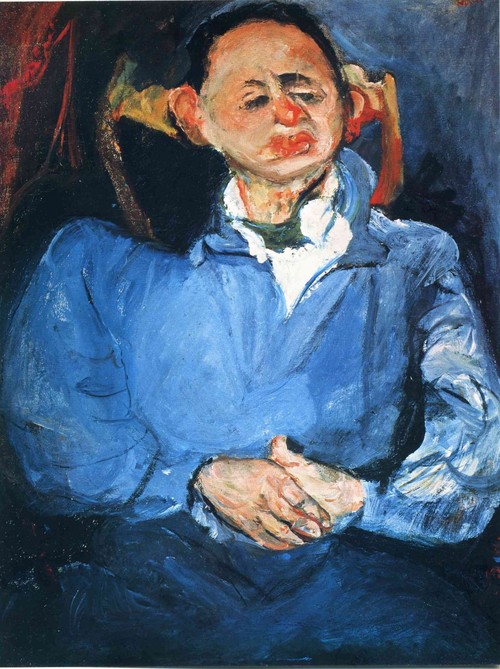Chaim Soutine. Beef and head of veal, 1923. Photo: Musée de l'Orangerie, Paris
Chaim Soutine, "The Houses" (Les Maisons), oil on canvas, 1921. Photo: Musée de l'Orangerie, Paris
Happy Birthday Chaim Soutine (1893-1943)!
by Samuel D. Gruber
It was only recently that I learned that I shared a birthday (January 13) with Chaim Soutine, one of my favorite painters. (Actually, though it is accepted that Soutine was born in 1893, the actual date is uncertain, but January 13th is frequently cited).
Soutine's colorful, messy, exuberant, thickly-laid, sometimes tortured, and wildly convulsed canvases are among the most purely painterly art works of the 20th century. Where Picasso was cool, Soutine was hot. Where Modigliani (Soutine's best friend) was dispassionate, Soutine was emotional. Where Chagall used narrative and symbols, Soutine's works tended toward the iconic: a face, a side of beef, a row of tilting houses. His energetic, sometimes manic brushwork jumps from the canvas, often entirely independent of the subject, and for this he is often considered the forerunner of Abstract Expressionism. Certainly Soutine always used subject - even if he did not need it. Though he looked back Rembrandt, there could not be De Kooning or Krassner if there had not been Soutine, and not Francis Bacon, either.
Chaim Soutine. Portrait of Oscar Miestchaninoff. Oil on canvas, 1924
"When you live in a dirty hole like Smilovichi, you cannot imagine that cities like Paris exist," Soutine is reported to have told a friend (Meisler, p. 9). Unlike Chagall, for whom his early life amid Jewish rituals, customs and language provided an endless source of nostalgia and interpretation, Soutine took his inspiration from artists of the past, what he saw with his own eyes, and his emotional state. Still, most of Soutine closest friends were other Jewish artists, especially in his early years in Paris. Soutine didn't speak or write about his art, and much of what we know of his life is anecdotal and told years after the events. So unlike interpretation of the work of many of his contemporaries, almost all analysis of Soutine's oeuvre must, the end, be personal, subjective and mostly ahistoric.
Chaim Soutine. Portrait of Paulette Jourdain, ca. 1928. Photo: Modigliani Soutine et leurs amis
Chaim Soutine. Le groom, 1928. Photo: Modigliani Soutine et leurs amis
One really needs to see Soutines's work up close in person to catch their energy, power and sometimes joy In America, that means going to the Barnes Foundation in Philadelphia. But on New Year's 2013 in Paris I had the joy of seeing Chaim Soutine: Order out of Chaos (L'Ordre du Chaos) at the Orangerie Museum at the Tuileries which combined its own paintings - mostly from the collection of Soutine's art dealer Paul Guillaume (many of which you can see here) along with many loans from American museums other than the Barnes. Since the Barnes is especially strong on Soutine's early career, this exhibit has a marvelous selection of his paintings from after 1922, including those of animal carcasses and many works from his stay in the south of France in Ceret in the Pyrenees. His landscapes from this period are wild and twisted and have been called "apocalyptic." To me they more recall of frenetic energy of Van Gogh's late work, but they also recall the near contemporary work of the German Jewish painter Ludwig Meidner, though I don't think the two artists knew each others' work. It is mostly the tenor of the times and Soutine surely knew other German expressionist work.
Soutine died in 1943. He escaped Nazi round-ups and lived on the run in France until his he died at age 50 after an emergency operation.
Any time is a good time to reacquaint oneself with the art of Chaim Soutine. So, Happy Birthday!
Soutine died in 1943. He escaped Nazi round-ups and lived on the run in France until his he died at age 50 after an emergency operation.
Any time is a good time to reacquaint oneself with the art of Chaim Soutine. So, Happy Birthday!
Chaim Soutine. The little Pastry Cook, ca. 1922-1923. Photo: Musée de l'Orangerie, Paris
Chaim Soutine. Landscape, ca. 1922-1923. Photo: Musée de l'Orangerie, Paris










6 comments:
I remember my shock/pleasure when I first encountered Soutine at the Barnes Foundation. What power! Thank you for this remembrance. I feel a bit closer to him now. My maternal grandparents were also from Belarus...Grodno.
Perhaps you know if there are any Jewish monuments left in Smilovici?
Perhaps you know if there are any Jewish monuments left in Smilovichi?
I've posted details about Jewish traces in the town here...
http://samgrubersjewishartmonuments.blogspot.com/
Soutine's work can also be found in Phillips Collection in DC.
Post a Comment